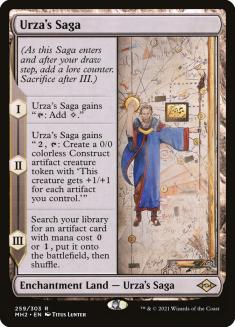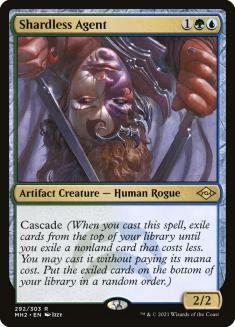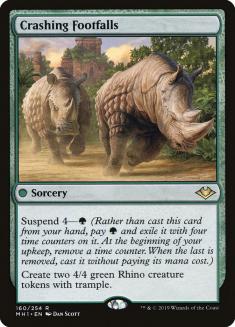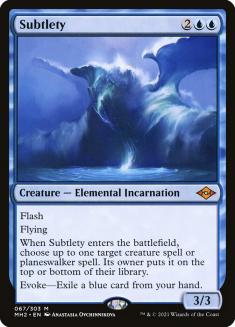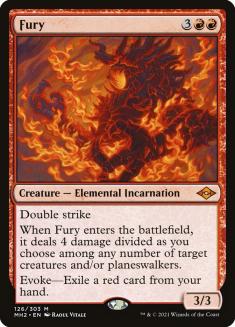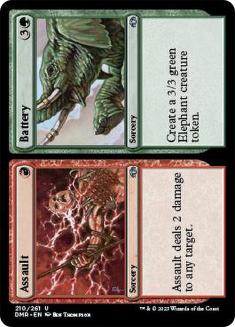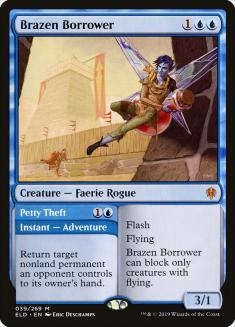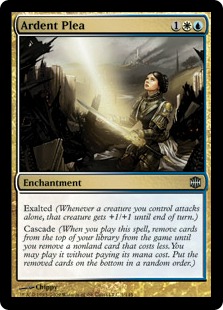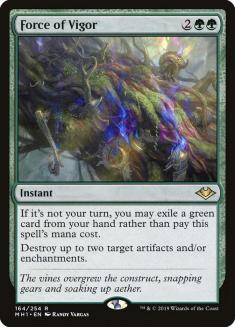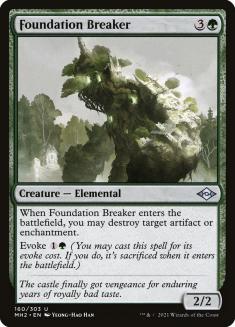Modern is going through turmoil as it incorporates and digests the powerful new tools from Modern Horizons 2. The last week has been full of movers and shakers, including some results from this past weekend’s Magic Online events. Every day brings new information as we test these new cards and decks against the field. Every archetype that feels broken but “slightly off” is slowly getting sanded down to its final form.
Urza’s Saga is my pick for card most likely to be banned in Modern first. That doesn’t mean we’ve reached that point yet. That doesn’t mean it’s going to be banned at all. My opinion is that the card is extremely good, goes into a lot of decks, and offers a lot of upside for very little risk. It’s a unique card that works in a way that few people have fully understood just yet. It tutors up some of the most disgusting artifacts ever created, and it doesn’t cost the pilot a single mana to get a major boost from it. Amulet of Vigor alone makes it somewhat terrifying.
Prophet / Profit
There are plenty of other “scary” cards in Modern Horizons 2, including the one I want to focus on today. Years ago, after the announcement of the first Modern Horizons, Ross Merriam and I decided to try out some “potential reprints” on VS Live! We tried all sorts of stuff, including Counterspell, that we thought would be powerful but ultimately fine in Modern. Shardless Agent was one of those cards.
I love Shardless Agent. I played it to a Top 8 at an Invitational back in 2012 right after it was originally printed. Alongside Brainstorm, you could put Ancestral Vision on top of your deck and use the cascade mechanic to generate a free burst of cards. In a grindy fair deck, that type of interaction is outrageous. Without Brainstorm, setting that up is a little more difficult, but that just means we need to find better ways to incorporate it into fair strategies.
My initial want was Shardless Agent in Humans. Cascade into a Human seemed pretty great. After all, your whole deal is getting warm bodies online for Champion of the Parish and Thalia’s Lieutenant, so a card that produces two of those warm bodies is dope. It’s also an artifact, which is cool for Urza decks that just want a high artifact count. Then you have the unsavory folk who want to watch the world burn by cascading into Restore Balance.
Now that Shardless Agent is in Modern, we can do with it whatever our heart desires. A few weeks ago, aspiringspike posted a sweet Temur Cascade build that focused entirely on a suspend card that has seen play, but was never really the core. Not like Living End, which requires you to play a bunch of creatures that cycle. Not like Restore Balance, where you have to play Fieldmist Borderpost and Greater Gargadon. Just a little card that makes your two best friends.
Crashing Footfalls is not splashy. It doesn’t end the game on the spot. It barely even scratches the surface of broken, which is basically the exact opposite you’d expect when someone is casting Shardless Agent into a suspend spell without a casting cost.
The difference between Crashing Footfalls and Living End is that the rest of your deck doesn’t have to be a gimmick. You get to play normal-ish Magic the entire game because your payoff is just “make some medium-sized creatures.” Instead of being vulnerable to Leyline of the Void, we’re vulnerable to Engineered Explosives and Fatal Push. The difference is that we’re expecting to be interacted with, and we don’t care.
When you cast an early Crashing Footfalls, you’re expecting the game to continue for a little while. Against control opponents, I doubt you’ll even get in one attack. Against midrange opponents, I’d expect both Rhinos to be dead in two turns. Because we’re going small, we don’t invest our entire deck into it. Because we’re not doing anything incredibly broken, the rest of our deck gets to be interactive. In a way, this feels like the new Splinter Twin.
Opportunity cost is a way for game designers to expand upon the idea of “putting all your eggs in one basket.” A deck like Izzet Gifts Storm requires you to play 30 or so cards all dedicated to the same gameplan. When you play a deck revolving around Crashing Footfalls, you just need to play Crashing Footfalls and a few three-mana cards that cascade into it. When your combo costs so little in terms of opportunity cost, mana cost, and resource cost, the rest of your deck is free to pursue whatever your heart desires.
Trading Cards for Pressure
Speaking of Legacy, one of the unique types of resource management is trading raw card advantage to create a landslide advantage. We see this when Delver decks use Force of Will to trade cards for time. Generating that time gives you a window to spend mana creating pressure in the form of creatures. When a control deck uses Force of Will, it’s almost always defensive. When a Delver deck uses Force of Will, it can vary in use drastically. Sometimes you just want to stop their Tarmogoyf from clocking you. At other times, you’re protecting your Lightning Bolt from a Thoughtseize. And other times still, you’re using Force of Will to keep Delver of Secrets alive so you can keep up the clock.
In Modern, Force of Negation is almost always used from a defensive stance. It acts as the great barrier, keeping the floodwaters of combo at bay. While Crashing Footfalls isn’t exactly Delver of Secrets, the nature of how the cards work together is roughly the same. When you have pressure on the battlefield, like a pair of 4/4 Rhinos or a 3/2 Insect, any counterspell is going to be ludicrous. Any free counterspell will allow you to apply that pressure with your mana while you get to spend the raw card resources in hand to protect that pressure.
With the advent of the mythic Elemental Incarnations like Subtlety, we get to hammer that gameplay aspect home. Creatures like Tarmogoyf or Primeval Titan are good at blocking Rhinos. Our life total is also somewhat in jeopardy from aggressive strategies because we don’t get to play efficient one-mana spells. Subtlety protects us from the cards that Force of Negation can’t. Unlike Legacy, many of the combo elements in Modern revolve around creatures. Those creatures are often backed up by Cavern of Souls, which just so happens to do nothing against Subtlety.
Our deck’s focal point is resolving Crash of Rhinos. The rest of our deck should be dedicated to protecting us from losing the game in unconventional ways or keeping our opponent from regaining a foothold on the battlefield. The reason we play Force of Negation and Subtlety together is because our entire goal is protecting us from the unknown. Let’s take a look at an unconventional build before we get into what I believe will become stock.
Creatures (18)
Lands (22)
Spells (20)
Sideboard

Let me start by saying that I might’ve gone a little overboard with the free spells. However, I’m of the opinion that Fury and Endurance are both solid to cast at full cost while offering you a way out of sticky situations when your opponent is attacking your mana. It only makes sense to fight Thalia, Guardian of Thraben with a card that decimates it. Fury just crunches down on your opponent if they try to rush you with a few cheap creatures in the early turns, disruptive or not. Just killing a Goblin Guide and Eidolon of the Great Revel for zero mana is enough to understand exactly what Fury adds to the program.
Endurance is here because I think it’s better in this shell than, say, Leyline of the Void or Ravenous Trap. Because we need our anti-graveyard card to be cheap but still avoid the mana value dilemma, our options are limited. We have to play a few weird ones to enable both Fury and Endurance, but the card I’ve added to fuel both is an effect that I already wanted.
I haven’t played this card in Constructed for about twenty years. It was one of the better Standard tools for Gruul-colored aggro decks, acting as cheap removal or threat depending on the matchup. What a world to live in!
Assault is just a sorcery-speed Shock, which is fine in most scenarios. Cheap creatures mostly die to it, and it can combine with Bonecrusher Giant’s Stomp in a pinch to take care of a larger threat. Dead // Gone is the alternative, but that makes your green count a little too low for Endurance. I felt like this was the “free slot” to help make Endurance playable.
Battery is probably not being cast often, but it still helps apply more pressure in a pinch when you don’t need a Shock. Versatility on cards like this is clutch.
I would play eight copies of Fire // Ice if I could. Both halves have done dirty things. It’s a removal spell that meets the mana value requirement and still pitches to both Subtlety and Force of Negation. Tapping your opponent’s land on the second turn can stall them out long enough for a single Crashing Footfalls to bury them. Every aspect of Fire // Ice sees use in the deck. It’s incredible.
The Adventure creatures have been so good in this deck that I’ve even been considering adding Lovestruck Beast to the sideboard. Petty Theft lets you bounce any problematic permanent in a pinch, but just the time it can buy from bouncing a cheap creature can be enough to put Crashing Footfalls over the top. Every little bit of interaction slows the opponent down so that Crashing Footfalls can run your opponent over.
The flying aspect of Brazen Borrower is also pretty sick. I’ve had it close the game multiple times, even if it’s just adding to the pressure that Crashing Footfalls has already created. It can be your answer to Chalice of the Void or Meddling Mage. It does everything you need it to do.
Bonecrusher Giant is not quite as versatile, and isn’t blue for pitching purposes, but Stomp can permanently kill a number of annoying creatures and Bonecrusher Giant itself can add an immense body for the cost to your already solid clock. Both these Adventure creatures are sick because they allow you to play conventional Magic without breaking the mana value requirement. As you can probably tell, meeting that mana value requirement while costing less than the advertised amount of mana is the most important aspect of deciding our utility spells.
Lock, Stock, and Two Smoking Rhinos
Matt Dilks once said “I decide what’s stock” for Amulet Titan. It was a powerful response to someone questioning his card choices mid-match. I’ve been on the cutting edge of archetypes before, and definitely helped influence what became stock after doing well in a tournament, but the testing it takes leading up to that point is arduous, and often requires playing with a bunch of cards that end up being bad. I want to be the person who makes the stock version of Crashcade, whatever it may be.
The Temur version has a lot of cool things going for it, but the one downside is that you only have two different cascade cards at three mana in that color combination. Violent Outburst and Shardless Agent are certainly the best of the bunch, but playing twelve ways to make Rhinos instead of eight means you’re less susceptible to discard, and you can follow up one Crashing Footfalls with a second on the regular. That helps fight through traditional interaction and creature removal.
Splashing white for a single card might not be worth it, but splashing white for two or three cards could offer answers to problems that you won’t find anywhere else.
Creatures (12)
Lands (24)
Spells (24)

The white splash here is almost entirely for Ardent Plea, an additional way to make some Rhinos. Ardent Plea giving something exalted has come up a few times already, but the primary focus is making sure we always have the option to make Rhinos on the third turn.
A long time ago, a friend of mine who was teaching me to get better at Magic gave me some advice when it came to building combo decks: play as many copies or virtual copies of a certain effect that you can, within reason. If our entire deck revolves around casting a cascade spell, why wouldn’t we want four more copies? It isn’t that hard to add a fourth color to our deck since we’re already playing fetchlands and shocklands, so adding white for Ardent Plea has a very low cost while increasing our rate of fire by a significant amount.
These two cards are questionable because our green count is usually low, but I’ve gone so far as to add Assault // Battery to this version to give us the same type of interaction as Bonecrusher Giant while adding four green cards to the deck for pitching. Endurance is one of the better sideboard options for affecting the graveyard, but Force of Vigor is on another level as far as artifact hate is concerned. If you ever get to blow up two different targets that actually have value, I can’t imagine losing the game.
If you don’t want to play Assault // Battery, I highly recommend replacing it with Bonecrusher Giant, but then you’d have to substitute Foundation Breaker and Leyline of the Void in their stead. I chose this direction specifically because I was not happy with Leyline of the Void, but there’s a substantial reason to play Leyline of the Void at the moment over one-shot graveyard removal: it hoses the Golgari Food deck.
Creatures (16)
Lands (24)
Spells (20)

Foundation Breaker adds an evenly costed Disenchant that doesn’t require you to play a ton of green cards. Force of Vigor is obviously excellent, but you need a certain number of green cards to play a pitch green spell. If we’re not playing Assault // Battery, I don’t think we have enough. Foundation Breaker fits the bill nicely, as we don’t need huge hosers for artifacts or enchantments. We just need something to slow them down.
I love the variable nature of evoke creatures. Foundation Breaker isn’t free like the mythic Elemental Incarnations, but it certainly has value cast for both the evoke cost and regular mana cost.
If it isn’t in your opening hand, it’s dead. That sucks, but it’s worth it against one of the format’s best decks. Golgari Food is popular and powerful, so having a hoser is important. Your options for interacting with the graveyard are few and far between if you need to meet your tough mana value requirements.
As for other Leylines, like Leyline of Sanctity, I don’t know that any others are worth it. I’ve been searching and theory-crafting around all sorts of cheap or free spells. It’s a fun exercise when building your deck requires filling a highly specific hole. Right now, I’m all about reduced cost, free, pitch, or split cards. Everything from those food groups is on the menu, but I’m sure I’m still missing something.
If you want a hammer against graveyard decks, just play Leyline of the Void.
A Set Forged in Fire
One thing to remember is that testing sets like Modern Horizons 2 doesn’t happen in a vacuum. When they were testing these cards, so many problems still existed. Companions weren’t nerfed, Uro was still around, and control decks still had Mystic Sanctuary. If these cards seem powerful, that’s because they are. I’m having a lot of fun trying to figure out which are the most powerful, but this just feels like the new normal.
My hope was that Modern Horizons 2 would offer fifteen to twenty new cards that could all be format-defining in their own way. I wanted decks to form their identity around these cards, and create an entirely new ecosystem. Old decks could adopt some new cards and exist alongside these new monsters, but the landscape would shift in such a way that would increase the overall power level of the format in a somewhat healthy way. Playing with juiced cards is a lot more fun than playing with weak ones.
I’ve had a blast playing with Modern Horizons 2, and I’m sure you will too. Just because one or two cards are a bit too powerful shouldn’t put a damper on the rest of the set. We’re still in the very early stages of what is and is not appropriate for Modern in terms of handling bans when a supplemental set enters the fray. It might be time to look at unbanning Faithless Looting and Splinter Twin instead of banning Urza’s Saga.
And that, my friends, is the circle of life.


